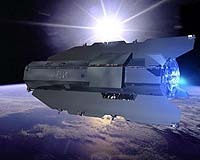The European Space Agency (ESA) said Monday it would take part in 10 major missions this year, including long-delayed trips to the space station, new explorations of Earth and deep space, and a joint unmanned trip to the Moon with India.
The missions on ESA's 2008 roster include the dispatch next month of two key components of the International Space Station (ISS), the orbital outpost being assembled by a US-led consortium of five partners.
They are a science module, Columbus, scheduled to be taken aloft on February 7 by the US space shuttle, and a robot freighter, due to be placed in orbit by ESA's Ariane rocket in the third week of February and then automatically rendezvous with the ISS.

|
| ©Unknown
|
| In May, GOCE, a satellite billed as "the Ferrari of micro-gravity fields," is scheduled to be taken aloft from ESA's space base in Kourou, French Guiana, with the goal of monitoring ocean circulation -- a key factor in the climate-change question.
|
At least two billion euros (2.9 billion dollars) have been spent on Columbus and the Automated Transfer Vehicle (ATV).
But their deployment has been delayed by several years because of problems with the US shuttle system, which has also led to a reduction in personnel aboard the ISS.
Cost overruns and frustrations at being unable to do scientific work that was the touted virtue of the ISS have caused fierce debate within the European space community about whether to join future prestige-driven multinational ventures.
ESA Director General Jean-Jacques Dordain, in a meeting with the press, said "billions" had been spent on these and other European components for the ISS.
"It is now time to draw the scientific benefit from them," he said firmly.
Other ESA operations this year include the European Union's Galileo programme to launch a constellation of navigation satellites to rival the US Global Positioning System (GPS).
There will also be an ESA payload aboard the Indian lunar orbiter, Chandrayaan-1, whose launch is pencilled in for April from the Satish Dhawan Space Centre.
In May, GOCE, a satellite billed as "the Ferrari of micro-gravity fields," is scheduled to be taken aloft from ESA's space base in Kourou, French Guiana, with the goal of monitoring ocean circulation -- a key factor in the climate-change question.
In December, ESA hopes to launch one of the most ambitious double launches ever in space science.
The orbital telescope Herschel will look for infrared signals pointing to the earliest events after the "Big Bang" that created the Universe, while a counterpart, Planck, will look for other primal energy in the microwave part of the radiation spectrum.
"They are two jewels, two splendid scientific missions," said Dordain. "With them, European industry has pushed back the frontiers of technology."
In other comments, Dordain reported a big surge of interest among eastern European countries to join ESA. The Czech Republic is expected to join in June, and the agency's membership roll could soon rise to 22 or 23 countries, he said.
ESA cooperates closely with the EU on a project-by-project basis, making for a relationship that is at times difficult. A stronger institutional role between the two entities is sketched in the EU's reform treaty.
The agency's 17 members are Austria, Belgium, Britain, Denmark, Finland, France, Germany, Greece, Ireland, Italy, Luxembourg, the Netherlands, Norway, Portugal, Spain, Sweden and Switzerland. Norway and Switzerland are not part of the 27-member EU.
Canada, Hungary, Romania, Poland and the Czech Republic also participate in some ESA projects under cooperation agreements.
Reader Comments
to our Newsletter